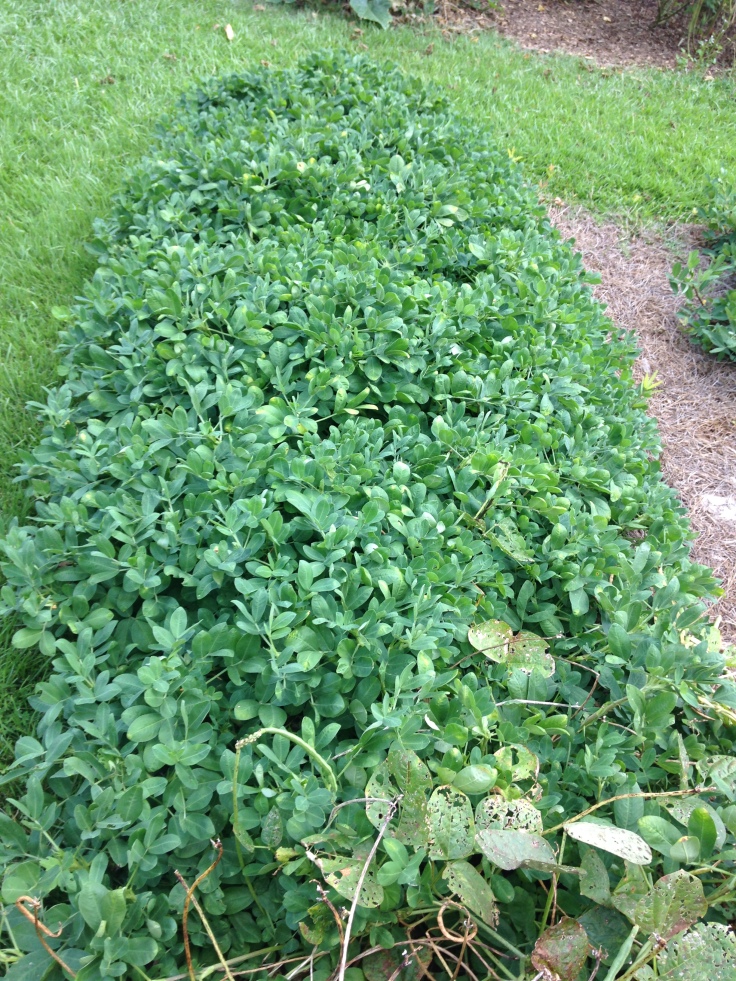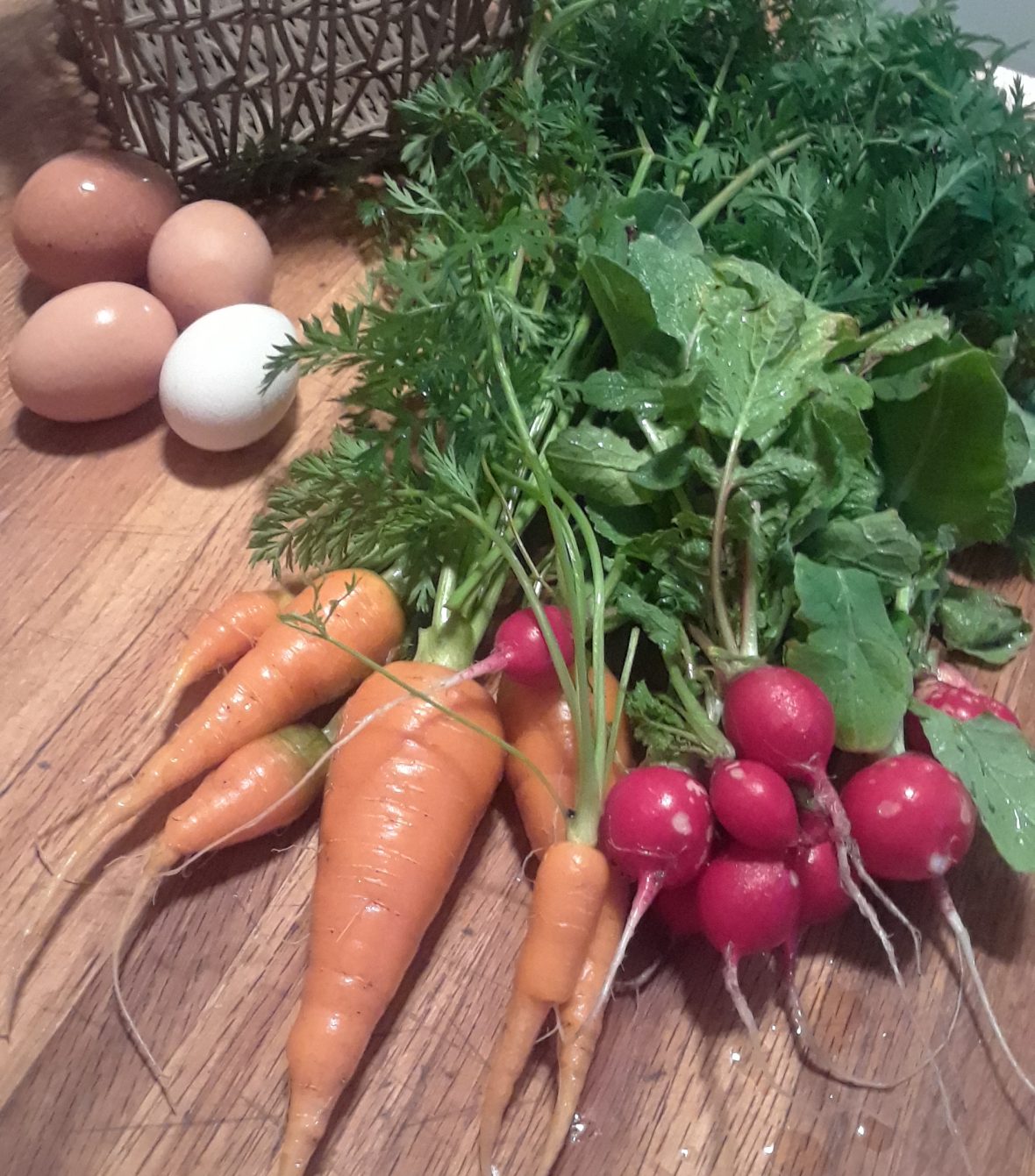Peanuts are farmed on almost 200,000 acres of Alabama land every year and this year our family proudly added 100 square feet to that total. We scalped sod and transformed a useless piece of pristine Zoysia lawn into a micro-peanut farm and have been thrilled with our little peanut patch. I am declaring it our greatest gardening success of 2018!
There were several old-timers that thought we were crazy for planting peanuts in our front yard. I was told “You can’t grow peanuts in a little garden. You need acres!” We have succeeded in proving them wrong. Not only did we grow peanuts, we actually produced around the same amount of peanuts I purchase every fall for boiling.
I know boiled peanuts are not well-known outside of the Southeastern US. So, for my non-Southern readers, I must describe the wonderful salty bit of heaven that is a boiled green peanut. When peanuts are freshly dug they are referred to as “green”, although they aren’t actually green in color. These fresh raw peanuts are boiled in a salty brine that is sometimes spiced with Cajun seasonings. The finished peanut is absolutely nothing like what the rest of the world thinks of when they think of peanuts. Boiled peanuts are almost like oily cooked beans inside woody shells. You bite the shells in half to remove the inner soft morsels and slurp down the salty juices from inside the shells. These salty treats are enjoyed with beer or ridiculously sweet tea. They are best in fall when peanuts have recently been dug.
Boiled peanuts are my oldest child’s favorite snack and might be my favorite as well. That was my motivation for growing our own. I try to feed my kids organic foods and I have never been able to find organic fresh green peanuts. So, I didn’t just grow them for kicks. I grew them to be able to feed organic peanuts to my kid. Yes, healthy organic?…..boiled in a super salty brine? So, maybe they aren’t the healthiest. But, at least they don’t contain pesticide residue.
Before planting our organic seed peanuts I thoroughly investigated them. My goober research included variety specific growth habits, plant spacing, nutrient needs, harvesting methods, and possible diseases. For months I had a George Washington Carver level of obsession. I will share the most important things I’ve learned in the Growing information at the end of this post.
After months of obsessing, I order two varieties of peanuts that are suitable for clay soils: Tennessee Red Valencia and Texas Red and White Striped. I shoveled up 2 long mounds and planted each of them in double rows on top of the mounds. The rows were spaced 12″ apart with the Valencia seeds staggered every 12″, and the Red and Whites staggered every 10″. There are many ways to plant peanuts. This is just the method that I calculated to produce the highest yield in our small space, and it worked quite well.
I planted a small pea patch at one end of the bed creating a U-shaped garden. If it weren’t for the peas, the planting would have looked very neat and tidy. By mid summer when the peanut plants had filled in the gaps, they looked almost like short hedges. The Valencias did sprawl a bit. But, the Red and Whites were incredibly neat and compact, probably the most well behaved front yard food we have grown. If I were to design a well manicured kitchen garden, I’d be tempted to plant in the style of French parterres with Texas Red and White peanuts instead of boxwood. But, digging up peanuts planted in an intricate design might not be much fun.
Digging up our little peanut hedges was fun. But, trying to determine the perfect time to dig was a bit nerve racking. I started worrying over our harvest date around 110 days after planting our crop. As I was reading all things related to peanut digging on the internet, I was amused by the array of methods and calculations used for determining when to dig. Commercial peanut growers struggle with timing just like front yard peanut growers. They use special charts designed to optimize harvest by calculating the perfect dig date. I do not have a peanut chart. So, I just poked around and pulled up a peanut every few days to see how filled out they were. The problem with my simple method is that peanuts are indeterminate plants. Meaning; they keep producing new peanuts as long as they are growing. So, the plants might have 20 shells filled out and ready to harvest with 10 immature shells. I don’t mind the little immature goobers (“pops”). Because they are actually delicious eaten shell intact after being boiled. I’d rather have plenty of pops than to have old sprouted or rotten peanuts. If they stay in the ground too long they can quickly turn bad. Late season rains can cause peanuts to sprout and entire harvest can be ruined.

If late summer weather is very dry and peanuts are going to be roasted, they can stay in the ground until the leaves turn yellow. The leaves on our plants had just started to get yellow spots when we dug them. Judging by the yield, I think our timing was perfect.
The first plant I pulled from the ground was loaded. I think I probably squealed with excitement. When I was able to inspect the total harvest from one plant. I realized they were all ready to pull. We had a few days with no forecast rain, so we were able to lay half of them on top of the ground to dry. The remaining half went straight into a classy blue plastic swimming pool for their first soak and rinse. Fresh raw peanuts that are going to be boiled require several soaks in fresh water prior to cooking. The pool was perfect for the first bath, and it made the harvest time a bit more fun.
Our total harvest from our 100 square foot planting was 20 quarts. This isn’t a huge amount of peanuts. But, enough to stock our freezer and pantry with some delicious treats.
The first half of the peanuts were either boiled customarily or pressure canned. Pressure canning is a great way to speed up their cooking time and to preserve fresh green peanuts. For more information check out Boiled Peanuts from the Pressure Canner.
Some of our groundnuts were eaten raw as snacks. Others were roasted and transformed into delicious peanut butter that has a rich toasted flavor, greater than any store-bought spread.  The remaining raw peanuts will be roasted or possibly fried. We will be snacking on our beautiful little crop all year long. Our front yard peanut farm got it done!
The remaining raw peanuts will be roasted or possibly fried. We will be snacking on our beautiful little crop all year long. Our front yard peanut farm got it done!
I will be making room for peanuts to be added to our crop rotation every year. This crop is valuable not only as a food source, but as a great nitrogen fixing, soil enriching plant. I will probably try to use peanuts to improve depleted soil in one of our raised bed gardens in addition to planting them in our front yard next Summer. If I had more time on my hands, I would plant an entire field of them, or at least our entire front yard. If you have as little as 40 square feet to plant, and at least 120 days of Summer weather, you should try growing these glorious groundnuts too. They are easy to grow, fun to harvest and absolutely delicious.

Growing Information
- Seed peanuts can be purchased through many large seed suppliers or any raw peanuts can be used for seeds. For areas with clay soil, I would highly recommend Red Tennessee Valencia. They produced over twice as many as the Texas Red and Whites. If you have space to spare and aren’t concerned with getting a high yield, the Texas Red and Whites are beautiful, more delicious and have a higher oil content. If you are in an area with sandy soil, you will have plenty of varieties to choose from; Black, Jungle Striped, Runners, Spanish and many more.
- Peanuts require long hot summers to mature and fill out, 110-150 days for most varieties.
- Peanuts do not require much nitrogen. But, do need calcium and magnesium to produce. I worked bone meal and epsom salts into the soil between my rows to provide these nutrients. For more information on nutrient needs for peanuts: https://www.southernstates.com/articles/nutrient-management-peanuts.aspx
- The nuts are not attached to “roots”. Instead, they form on the end of “pegs” that drop down from the bright yellow blooms of the peanut plants. These pegs need soft and damp soil to attach and form. Covering the soil with pinestraw helps keep the surface moist and penetrable.

- Water frequently when peanuts start blooming and stop watering 90-100 days after the plant date. Watering during the end of season can cause the crop to sprout.
- Dig when leaves just start to yellow if the peanuts will be boiled or if rain is in the forecast.

- Carefully dig peanuts with a digging fork or broadfork.
- Enjoy snacking on freshly dug raw peanuts. Just don’t enjoy too many at one time.



*LOVE* your posts.
LikeLiked by 2 people
Fried peanuts? That sounds amazing! I grew up in Alabama but have never tried those. How do you fry them?
LikeLike
I haven’t actually tried frying them yet. But, I have tasted them and they were great.
LikeLike
Dig the peanut vines back into the soil or compost them. They are nitrogen rich legumes. They really make corn grow when the corn is planted behind them the next year
LikeLike
Ours went into the compost. We always need compost green.
LikeLike
This Georgia girl might give growing her own peanuts a try! Thanks for the information neighbor!
LikeLike